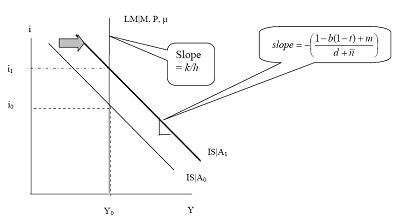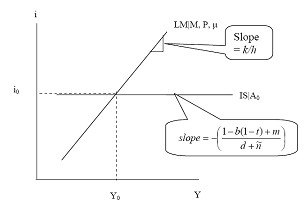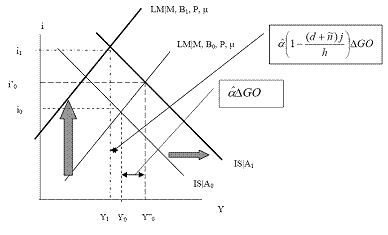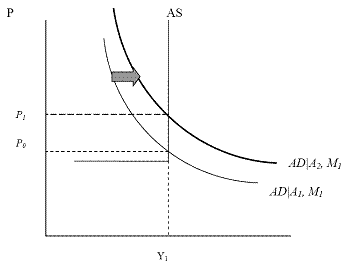It’s been frustrating to me that so much virtual ink has been spilled about why the fiscal package will or will not be effective, with so little clarity. Lots and lots of words are being thrown around, [1] [2] when a lot of the arguments can be summarized pretty easily in terms of four cases, and hence four graphs (I won’t deal with the fifth, in detail). There are numerous excellent critiques; here in the interest of specificity, the exposition will be fairly dense.
1. With prices predetermined, the interest sensitivity of money demand is zero, or the income sensitivity of money demand is infinite.
2. With prices predetermined, the interest sensitivity of investment or the sensitivity of net exports to interest rates are infinite.
3. With prices predetermined, the sensitivity of money demand to wealth is high.
4. Output is at full employment levels.
5. Neo-Ricardian equivalence, as put forward by Barro, holds.
I’m going to use standard graphs from a standard macro textbook (Hall and Papell) in Figures 1 and 2. These rely upon the Hicksian decomposition that assumes that one can model the flow equilibrium in the real side of the economy and the stock equilibrium in the financial/asset side of the economy, or the framework otherwise known as the IS-LM model.
Consider case 1 (“funky” money demand behavior): If the interest sensitivity of money demand is 0, then the LM curve is vertical, so as spending rises (shown by the gray arrow) and drives up money demand, interest rates have to rise sufficiently to as to reduce investment so that output is back to the original level; or the income sensitivity of money demand is infinite so that as soon as output rises money demand rises infinitely so interest rates have to rise so much as to reduce output back to the original level. I don’t know of any studies that suggest these parameters are plausible.

Note: k is the income sensitivity of money demand, -h is the interest sensitivity of money demand, μ is the constant in the money demand equation, b is the marginal propensity to consume, t is the marginal tax rate, m is the marginal propensity to import, -d is the interest sensitivity of investment, -n is the interest sensitivity of net exports.
Case 2 (interest sensitive components of aggregate demand like housing and business fixed investment are really sensitive): The interest sensitivity of investment is so high that as soon as output rises, interest rates rise by epsilon, driving down investment so that income returns to original levels. The same logic works if the interest rate sensitivity of net exports is infinite (higher interest rates induce a stronger dollar which increases imports and decreases exports).

Interestingly, many critiques of the effectiveness of monetary policy (low interest sensitivity of investment) imply effective fiscal policy.
These cases are the ones in which fiscal policy is completely ineffective. Many of the arguments against a fiscal stimulus being effective seem to focus on the marginal propensity to consume being small; holding all else constant, this would indeed mean a smaller multiplier. But fiscal policy would still be able to increase output. The layout of the model and the analysis of non-pathological cases is here [pdf].
Case 3 (households and firms like holding a lot of their wealth in the form of cash, holding interest rates constant): The wealth sensitivity of money demand is very high, so when a budget deficit is run, wealth (money plus government bonds) held by the private sector rises, pushing up the equilibrium interest rate.

Where j is the wealth sensitivity of money demand (i.e., when wealth rises by $1 billion, money demand rises by $j billion); and α-hat is (1-b(1-t)+m+(d+n)k/h) -1
This is “portfolio crowding out”, that is where government borrowing — associated with deficit spending — in the credit markets raises interest rates on government bonds (decreases the price of government bonds).
However, a large j doesn’t seem plausible to me, except perhaps in times when risk aversion is extremely high. That applies to the current moment, but with risk spreads declining, I think that concern will be less relevant over time.
What seems more plausible is that μ increases exogenously — but that argument would carry even in the absence of a fiscal expansion. So one might as well undertake the fiscal stimulus. The derivation of the model is here [pdf].
Case 4 (no need to do anything — we’re already doing as well as we can): Output is at full employment levels. This can be true if we are in a Classical world (the aggregate supply curve is like one big production function, and is vertical in price-income space), in the New Classical/ real business cycle world, or in the Lucas supply curve (approximately a Classical model with uncertainty and rational expectations) world (see here [pdf]). But, if one is working in the neo-Classical synthesis, this would be shown as the following:

So, if the aggregate demand curve intersects the vertical portion of the aggregate supply curve, then an increase in aggregate demand only increases the price level. Of course, what an AD curve intersecting the AS curve on the vertical portion means is that there are no underutilized resources in the economy. That hardly seems a plausible interpretation of the current situation.
I would say that a “backwards-L” shaped aggregate supply curve is a little implausible in the medium run (and is not standard in most macro textbooks). Hence, for most parameter configurations, fiscal policy will have some effectiveness, as long as prices are somewhat sticky.
Case 5 (government debts will have to be paid off in its entirety the future): When budget constraints hold with certainty intertemporally, and there is no way to default even partially on government debt (say via unexpected inflation), then increases in government debt due to tax cuts (for instance) induce no change in curent consumption because households fully internalize the present value of the future tax liability. This “neo-Ricardian equivalence” (not that Ricardo actually believed in it) makes some sense, although to my knowledge no empirical studies support it holding in full.
Now, there are plenty of other, more reasonable, critiques that pertain to the degree of efficacy (how big the multiplier is, whether the spending will occur in time, etc.):
- Timing (I): That is the argument (not yet proved) that much of the spending in this bill will occur not within the next 18 months [0]. This argument seems to be based on this CBO computer run of a component of an earlier proposal, not the current plan (see Dean Baker). Hence, one needs to await an assessment of the current proposal before one can jump in. Second, even if some of the spending is going to occur outside of the 18 month time frame, well, that still might be relevant; see this post.
- Timing (II): Spending will occur in the future, even after the long downturn (here is a passionate statement of that argument ). Although, if one believes in rational expectations, then higher aggregate demand in the future will induce higher spending today. I’m skeptical of the strenght of this intertemporal linkage, and agree it would be better if the spending could occur sooner rather than later.
- Small marginal propensity to consume (the b parameter in the discussion above). This is a hard one to believe for a country with 70% of GDP accounted for by consumption, but it’s true that a case can be made for a smaller MPC going forward. Nonetheless, that seems to argue for a bigger stimulus, not none at all. And the relevant MPC is not a given; it depends upon where the spending or tax cuts are directed at. That’s why I’ve argued for tax cuts to the poorest and most liquidity constrained, and spending on goods and services (rather than nontargeted tax cuts and transfers to high income deciles) [1].
That last point drives my skepticism about demands for a much greater role for tax cuts as opposed to spending, as suggested by some (e.g., [2]).
There are of course a whole host of ideologically based arguments against increasing spending and/or cutting taxes further. I leave those points for others to debate.
Very helpful comments, especially for us micro people. Many thanks.
Thanks. Let’s hope Cochrane reads your piece, rather than wading his way through the textbooks he read from the 1970’s.
“This is a hard one to believe for a country with 70% of GDP accounted for by consumption, but it’s true that a case can be made for a smaller MPC going forward.”
A mere footnote in your essay but consumption data shows a collapse starting in Oct. There is every reason to expect mpc to cliff dive in 2009.
But how to force consumers to spend when commodities serve as global monetary surrogates?
One additional reason:
6. Anticipating higher future taxes on the returns from capital, the profitability of investment falls, so investment demand declines. (Similar to neo-Ricardian Equivalence, but not the same, because it is not based on lump-sum taxes).
And, purely as a theoretical curiosum (because I can’t resist):
7. Government spending is a perfect substitute for private investment (the government undertakes the same investment projects the private sector would have undertaken anyway).
8. Government spending is a close substitute for current consumption and a strong complement for future consumption, so consumption declines. (I think that would work, but I haven’t done the math to check).
9. In an economy of multiple equilibria, where people think the fiscal multiplier is negative, lower expected income causes a decline in consumption and the expectation is self-fulfilling.
Case 5 is not sufficiently strong. The counter-example I’m thinking of involves heterogeneity of family size. With intergenerational altruism, families with more children understand that they will pay a higher share of future taxes and therefore increase their savings by more than the increase in G; families with fewer children do the opposite. Depending on how this correlates with the distribution of existing income, the net effect can be contractionary or expansionary fiscal policy.
More generally, this serves to make the point that the cross-sectional correlation of future tax burdens with current income matter.
I had it pounded into my head again and again in graduate macro classes that IS/LM was a defunct model that nobody believed anymore, and was not taught except in undergraduate texts anymore. Is this incorrect?
SvN: Interesting point, but I think this speaks to efficacy, not complete ineffectiveness. One would still need each family dynasty to internalize completely the present value of tax liability in order to change consumption; I grant you this the resulting consumption will not exhibit a one-for-one pattern with current, observed income since permanent income and current are not the same (although usually, I think in tests of the Barro hypothesis, researchers typically assumed some sort of simple, stable autoregressive process for income, yes?).
o: Nobody literally believes in IS/LM. It’s a pedagogical device. You can replicate the predictions of IS/LM with more sophisticated general equilibrium models, with varying degrees of micro-foundations. Sticky prices combined with some sort of real rigidity can do the trick in some models, for instance. Sometimes they’re not enough. But do you believe a simple flex-price RBC with perfect credit markets does the trick? So the question is what basic framework you use to organize your thoughts for a given question.
“6. Anticipating higher future taxes on the returns from capital, the profitability of investment falls, so investment demand declines. (Similar to neo-Ricardian Equivalence, but not the same, because it is not based on lump-sum taxes).”
Like when Clinton raised taxes in 1993-4, which prevented good economic times from ever happening in the late 1990’s.
Menzie, just wondering how this schism fits into your 5 bullet points.
The DeLong vs. Murphy debate seems to me to be the crux of the disagreement, which seems to parallel your bullet points, but is not exactly the same. Arnold Kling, as usual, puts the disagreement into English.
From the learner’s point of view this is a really superlative post. Thanks much.
Menzie: Barro-Ricardian equivalence does say tax policy cannot change aggregate demand but it does not imply that changes in government purchases do not as I note here:
econospeak.blogspot.com/2009/01/ricardian-equivalence-does-not-imply.html
Here’s another 6th reason: leakage. The more open an economy, the less fiscal stimulus works. Instead, it simply leaks out.
In the case of the US economy, imports are equivalent to 15% of GDP. Stimulus will increase that somewhat to maybe 18-20%. Meanwhile, exports are only 9% of GDP.
For every dollar of stimulus, $0.18 leaks abroad but only $.09 returns. So the multiplier effect is negative (-$.09). (The -$.09 comes back from abroad to help finance the debt that the stimulus package created in the first place.)
Mainstream economists still seem to think we’re living in a closed economy. Keep dreaming, guys!
I’m not a professional economist (though I have an MBA), but I’ve been bothered enough by the controversy that I’ve done a couple of detailed research dives looking for information on good, unbiased empirical estimates of just the value of the multiplier in the U.S. economy. Other than finding a lot of research evaluating the estimates that Keynes came up with in the 1930s of the U.S., with some of the debate revolving around whether the multiplier was higher than three, or below three:
http://hetsa.fec.anu.edu.au/review/ejournal/pdf/38-A-1.pdf
One concern I have is that a very large amount of government spending is about to be directed toward projects where the experts have left me confused about how certain we are that the spending will add to the GDP $ for $, or at some level a little or a lot below that.
1. What is the conventional wisdom (or consensus) of the less-biased economists in the middle on the value of the multiplier: (a) right now, and (b) at what rate does the value of the multiplier fall as government spending is ramped up?
2. In a simplistic GDP framework where GDP = C + I + G + netX, my understanding is that I and netX are sensitive to G with a negative sign that somewhat (or completely?) offsets the value of the new government spending. That is, as G increases then savings declines so investment declines, and/or also the netX “leakage” mentioned by JohnH in his post occurs. So, what say the midstream, mainstream economists about this issue in this framework, if anyone would please help me out.
Thanks much.
JohnH: According to NIPA figures, for 08Q3, export to GDP ratio is 13.7%, while import to GDP is 18.6%. Looking at ex-oil, import to GDP figures are 14.9%.
You might be excused for not following every post on Econbrowser, but I have talked extensively about open economy ramifications; see post 11/25/2008, post 11/17/2008, post 11/27/2007.
pgl: Good point — although in the typical modeling exercise, all government spending is just wasted, in which case it’s hard to say one is benefitting.
Buzzcut: Have to think about this a bit…
I used estimates for exports, imports, and GDP from the CIA world factbook. I am glad you took up the issue of leakage last November.
Nonetheless I am appalled at the lack of public discussion of this by respectable economists regularly published in the mainstream media.
JohnH: Read Econbrowser, and you’ll always get a healthy dose of open economy macro perspective…
More seriously, the nominal import and export figures have changed substantially, especially imports, as oil prices have plunged.
The argument seems essentially to be:
1) Prices have no real meaning and are not effected nor do they effect.
2) Supply and demand are inconsequential.
3) Consummer preferences are the enemy.
Mercantilism and corporate welfare are the best solution to economic problems if they are effected through monetary policy.
Buzzcut,
It appears that in the Kling discussion of Murphy and DeLong there is a mistake that is typical of demand side economists. There is an initial investment of $100 taken from savings so to break even there must be a return of at leaset $100.
DeLong returns $87 for a $13 loss.
Murphy loses $80 for a $180 loss.
Okay anyone who supports this kind of investment have I got some swamp land for you.
I would say your point four can’t simply be stated like that:
“4. Output is at full employment levels.”
Historically, the employment picture goes something like this. From the forties until now, the government employs about 15-17 percent of the employable population. At the moment, on all levels, the number comes out to 22 million people. During this period, at any one time, let’s say an average of 4-6 percent are unemployed. That leaves the private sphere employing 80 percent, maximum. In other words, in the U.S., as in all developed countries (in most of which the Government employs even more), the private sector is pulling its weight when it reaches 80 percent employment.
At the moment, it isn’t pulling its weight. It looks like unemployment, which will mostly be from the private sector, will lower that percentage to between 75 – 77 percent.
Once you decompose your no. 4, you have a much better basis for discussing what, exactly, should be done. If the proposition is that the private sector can come back over the next year and absorb the 3-5 percent of the unemployed, I’d like to know: how do you think this is possible? I can see how it would be possible, on the other hand, for the government to borrow money to absorb that 3-5 percent. I could even see the government not only using money directly, but funding a re-industrialization bank to loan money to get the private sector in gear. According to a study made by a Duke economist, who surveyed enterprises (midlevel and large, I believe), 56 percent said that they would like to borrow money at this time, but were having trouble doing so.
Decomposing 4 gives you a much better map to the options ahead of us. If you start your modeling without touching base on recent history, you are simply working in a vacuum. Especially if your model tacitly assumes that full employment equals 100 percent private sphere employment, which hasn’t been the case since before 1929. First, you have to account for that fact – then you can move on to model either monetary or fiscal solutions.
Menzie –
There are a lot of implicit assumptions built into your model. For example, suppose foreign currency interventions are a function of political pressure from the U.S. and that this pressure is a function of increases in the unemployment rate. You would need to model this with shifts in your curves, not movements along them. I think, for example, that the loose fiscal and monetary policies of Greenspan and Bush (the tax cuts), by forestalling unemployment, helped allow Asian currency mercantilism to go unopposed, which led to a quick resurgence of the U.S. trade deficit, despite lackluster U.S. growth. The result is that much of the demand created by these policies was siphoned off into a bigger trade deficit.
I don’t think anyone is arguing the extreme case of absolutley no effective increase in demand from fiscal policy stimulus. It is all a matter of degree. But I fear that the current debate will result in no adjustment to the underlying international imbalances that got us where we are and that really need to be addressed sooner rather than later. Without care, the foreign sector leakage will be considerable and would worsen already unsustainable trends.
Excellent summary. I think that there is one important practical observation which might be added. Cases 2 and 3 assume non accomodating monetary policy. At the moment this is very unrealistic. The FED is clearly pedal to the metal. An increase of safe short term nominal interest rates would be countered by the FED. I don’t see how a fiscal stimulus can reduce expected inflation so I don’t see how it could cause increased real interest rates either.
Case 4 implies that a fiscal stimulus would make things worse (since they are assumed to be perfect now). However, it is just not true that it would have 0 effect on output. In particular increased Government consumption would crowd out consumption for fixed labor supply. This should cause increased labor supply. Case 4 requires market clearing *and* exogenous labor supply. It is not consistent with real business cycle theory in which labor supply is endogenous.
Again in case 5, if there is Ricardian equivalence tax cuts have no effect on GNP but increased G can have an effect on GNP by crowding out private consumption and increasing labor supply. This can cause GNP to increase even if there is unemployment if matching of the unemployed and vacant jobs is not perfectly efficient which it isn’t.
So really the cases are down to case 1 and the question is “is the velocity of money constant ?”.
All empirical estimates say no.
Buzzcut: In re your query: Hard to translate the Housework and Galbraith effects to the graphs, since they presume accurate measurement of output. The Feldstein effect shows up as a shift inward of the vertical AS curve in price-income space.
I think, for example, that the loose fiscal and monetary policies of Greenspan and Bush (the tax cuts), by forestalling unemployment, helped allow Asian currency mercantilism to go unopposed, which led to a quick resurgence of the U.S. trade deficit, despite lackluster U.S. growth. The result is that much of the demand created by these policies was siphoned off into a bigger trade deficit.
I believe that is Menzie’s position about tax cuts in general. He’s got a number of posts with that implication (tax cuts drive trade deficits).
It seems to me the bottom line is that the Bush years have been an enourmous Macro experiment. We’ve had unprecedented fiscal stimulus through the tax cuts and spending. The tax cuts we’ve had have been both supply side and demand side (the rebates).
Now, we’ve got a crisis. And the solution to the crisis is… demand side tax cuts and unprecedented spending?
If they didn’t work before, why are they going to work now?
You know, at least Bob Rubin tried something different in the ’90s. Raise taxes, get our fiscal house in order, and cater to the whims of the bond market. I think that there’s a lot of revisionism on Rubin’s part about how all that went down (i.e. Newt made him do it) but at least it was a coherant story and perhaps something new.
And maybe it even worked.
So… who’s ready for some austerity?
Remember Jeffery Sachs and his “Shock Therapy” for the fomerly communist countries? We need shock therapy.
Quoting Buzzcut:
“It seems to me the bottom line is that the Bush years have been an enourmous Macro experiment. We’ve had unprecedented fiscal stimulus through the tax cuts and spending. The tax cuts we’ve had have been both supply side and demand side (the rebates).
Now, we’ve got a crisis. And the solution to the crisis is… demand side tax cuts and unprecedented spending?”
I think it’s important to consider that spending $1 on military consumption is unlikely to have the same effect that spending $1 on infrastructure or other investment does. G is composed of both investment and consumption, and one might expect a shift in proportion between components might be important.